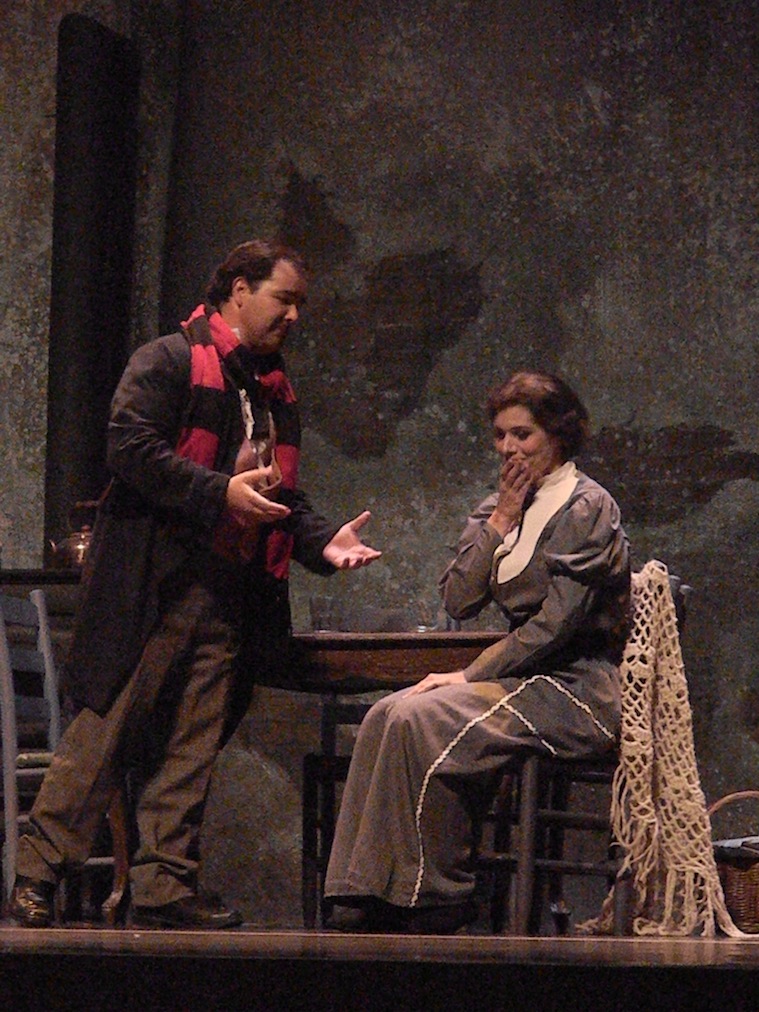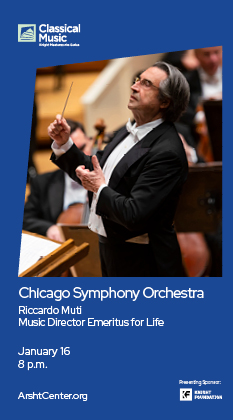With a strong cast, Miami Lyric Opera’s “La boheme” touches the heart

Rodolfo Cuevas and Natalie Avila in Puccini’s “La boheme” at Miami Lyric Opera. Photo: Maria Menendez.
Miami Lyric Opera’s production of Giacomo Puccini’s La bohème filled the seats Saturday night at downtown Miami’s Olympia Theater at Gusman Center. Pre-curtain, techno music pumped through the gilded, glittering halls, generating Miami-style excitement.
MLO’s La bohème, however, doesn’t pretend to be cutting edge, depending instead on a close-to-the-score rendition and strong voices. For newcomers, Bohème is the ideal entry-level opera, the love story of the ingenuous but tragically ill seamstress Mimì and the poverty-stricken poet Rodolfo.
From the start, conductor Doris Lang Kosloff whipped the orchestra together with commanding, passionate musicianship. Although the instrumentalists overpowered the singers for those in the closer seats, the blend in the rest of the hall was spot-on, with Kosloff’s crescendos underlining the most thrilling moments.
A palette of burgundy, black, and gold evoked a garret in Paris’ Latin Quarter shared by four starving artists – a poet, a painter, a musician, and a philosopher – who nevertheless find every opportunity to celebrate life. The two leads, played by tenor Rodolfo Cuevas and soprano Natalie Avila, brought exquisite voices to their roles, although dramatically their meet-cute was not particularly convincing.
As secondary leads Marcello and Musetta, baritone Oscar Martinez and soprano Beverly Coulter offered more seasoned performances, from their captivating opening appearances in Act I and Act II, respectively.
Rounding out the cast was baritone Daniel Snodgrass playing the kind, perceptive musician Schaunard, and bass Diego Baner as the droll philosopher Colline. Doing effective double duty as landlord Benoît and the cuckolded state councilor Alcindoro was bass Ismael Gonzalez.
The opening male quartet established Martinez and Baner as the stronger voices, with Cuevas thin in comparison. Although tightness persisted in Cuevas’s “Che gelida manina,” he gradually developed into an extremely expressive and sympathetic portrayal.
With Mimì’s “Sì, mi chiamano Mimì,” Avila was necessarily wholesome, but lacked crucial depth of interpretation to show how small her simple life is, and how she might fall in love so quickly and deeply. However, by the climax, Avila’s mellifluous voice promised a more layered character. By “O soave fanciulla,” we are on-board with the romance.
A colorful crowd scene in Act II conveyed a Christmas atmosphere with a delightful children’s choir swarming toy-vendor Parpignol. One could nitpick that Mimi’s pink bonnet is neither pink, nor a bonnet. Mimì should have swapped out with the chorus member who was wearing one in the right style and color.
In a grand entrance as Marcello’s love interest Musetta, Beverly Coulter flounced around the stage, a terrific foil for the quiet Mimì. With a riveting presence and superb vocal control in the famous “Quando me’n vo,” it’s lucky that she is paired with Martinez, the only other singer capable of drawing attention from her. Her clowning here makes her compassion in the final scene all the more affective. The ensuing ensemble, complete with marching band, built momentum into a terrific, jovial climax.
Act III and IV are devoted to deepening the two love stories, complicated by on-again, off-again dynamics. A well-staged pair of duets evolving into the quartet “Addio dolce svegliare alla mattina,” pitted the tempestuous Coulter and Martinez behind Avila and Cuevas’ tender exchange of love, parting and temporary reconciliation.
By Act IV’s ensemble, the singers were perfectly matched and fully defined. Rodolfo and Marcello’s duet “O Mimì, tu pìu non torni” warmed magically into a hilarious dance/fight scene, before beginning the tragic downward spiral at the opera’s end. A brief star-turn by Baner in Colline’s final aria “Vecchia zimarra” revealed a superb bass and ability to connect with his audience.
Avila’s gorgeous tone on her final aria “Sono andati,” and the ending driven by Cuevas, make the opera worth the price of admission.
Miami Lyric Opera will repeat La bohème 4 p.m. Sunday at the Olympia Theater at Gusman Center in downtown Miami. miamilyricopera.org.
Posted in Performances
One Response to “With a strong cast, Miami Lyric Opera’s “La boheme” touches the heart”
Leave a Comment
Sun Aug 17, 2014
at 12:49 pm
1 Comment






Posted Aug 17, 2014 at 2:48 pm by Pamela DeVercelly
Just so you know, for future reference, Mimi’s “La Cuffietta” or bonnet is supposed to be very small so Rodolfo can put it in his pocket and give it back to her in the 4th Act when she is dying. Thus she knows he cares.